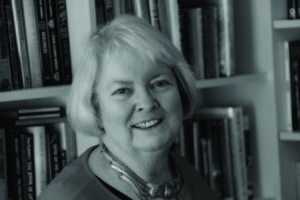
Margaret Maron (1938-2021) said that she “grew up on a modest two-mule tobacco farm that has been in the family for over a hundred years.” Although tobacco is no longer grown there, she had strong memories of working tobacco from singing, laughter, and gossip to sweaty faces and ice-cold drinks, and “the sweet smell of soft golden leaves as they’re being readied for auction.” She called such work “one of those life experiences I’m glad to have had,” then added, “I’m even gladder that it’s something I’ll never have to do again.”
The tensions between history and possibility—and our complex and sometimes contradictory relationships to each of those—lie at the core of the best Southern writing and are surely the hallmark of Maron’s own fiction. As she said, her character Deborah Knott was created by design as a “young woman with one foot in the agrarian past and one foot in the urban present,” and the books and characters always “walk that tightrope between Southern archetype and Southern stereotype.” But unlike those writers in exile looking at their native lands from a distance, Maron came home, lived on the corner of the family farm, and proved you can say a lot from that same plot of land you were born on—and equally so from that familiar patch of the literary landscape known as mystery fiction.
The traditional mystery novel is a formula of sorts, one that Maron herself frequently compared to the sonnet—a fixed form, an artificial form perhaps, but one which has nonetheless allowed poets great freedom of expression and room to examine a wide range of issues. While the first of the Deborah Knott novels, Bootlegger’s Daughter (1992), had already begun to explore women’s changing roles in Southern society, shifting attitudes toward sexuality and the continually troubled state of contemporary race relations, it was while writing Shooting at Loons (1994), the third novel in the series, which circled conflicts between menhaden fisherman and environmentalists, that Maron embraced a greater partisanship—the desire, as she said, “to speak out on the issues” facing North Carolina at the time.
Although the series as a whole has explored regional moral and manners, individual novels have also focused on themes reflective of the state’s swiftly shifting political, social, and cultural landscape. Gender issues and the persistence of racial prejudice thread through many of the books—the latter at the forefront of 1998’s Home Fires, about the burning of black churches—but Maron also looked at a variety of other pressing topics: immigration; the conflicts between agriculture and industrialization; threats to the state’s ecosystems; the dangers of overdevelopment; the terror of domestic abuse; the challenges facing an aging population; and much more. Her own partisanship aside, she examined these issues from various points of view, and in the process she’s both documented and fully dramatized what it means to live in North Carolina in the late twentieth and early twenty-first century. Those folks from Prague and Bangkok travelling with her books in their luggage aren’t simply getting handy travel guides but incisive portraits of a region undergoing significant change and often facing daunting crises.
Hand in hand with such moves, Maron’s fiction also changed the landscape of the mystery genre—moving it away from the mean streets of urban America to the main streets of the country’s small towns. She was credited with leading a resurgence of the regional crime novel—and her commitment to the genre she called home has been marked by the same respect for tradition and push for change that distinguished her fiction. She served as president of Mystery Writers of America (MWA), the country’s leading organization devoted to mystery writers and the success of the genre, and perhaps more importantly as both a founding member and a former president of Sisters in Crime, dedicated to encouraging and promoting women crime writers.
Winner of several major American awards for mysteries (Edgar, Agatha, Anthony, Macavity), her works are on the reading lists of various courses in contemporary Southern literature and have been translated into sixteen languages. In 2004, she received the Sir Walter Raleigh Award for best North Carolina novel of the year. In 2008, she was honored with the North Carolina Award for Literature. (The North Carolina Award is the state’s highest civilian honor.) In 2013, she was named a Grand Master by Mystery Writers of America for lifetime achievement, and in 2016, she was inducted into the North Carolina Literary Hall of Fame.
As with the best of the Fugitive Poets who celebrated our Agrarian past or the works of any number of writers in exile, Southern or otherwise—Thomas Wolfe, Richard Wright, even James Joyce—the power of Maron’s stories rises from the tension between the desire to celebrate place and savor tradition on the one hand and, on the other, the need to see those places and traditions with a keen and objective eye: to recognize pervasive and sometimes troubling social and political issues, to call out injustice in all its forms, and to look toward a better, more progressive tomorrow.
MEDIA
Long Upon the Land (Grand Central Publishing, 2016)
Buy this book from your local bookstore or www.Amazon.com.
Read remembrances of Margaret by:
Watch Margaret Maron on UNC-TV’s North Carolina Bookwatch with D.G. Martin:
Courtesy of UNC-TV.
Click here to read Margaret Maron’s acceptance speech at the 2016 North Carolina Literary Hall of Fame Induction Ceremony, Sunday, October 16, at the Weymouth Center for the Arts & Humanities in Southern Pines, NC.
Courtesy of Margaret Maron.
Watch Margaret Maron talk about her work at the 2012 Durham Reads Together event:
Courtesy of the Durham Library Foundation.
Watch Margaret Maron read from her book, Uncommon Clay (Warner Books, 2002):
Courtesy of the North Carolina Arts Council.
LISTS
Books
